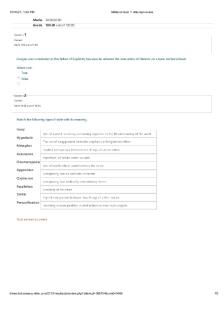GWS Midterm Quiz Questions PDF

| Title | GWS Midterm Quiz Questions |
|---|---|
| Course | Gender Women Studies |
| Institution | University of Illinois at Urbana-Champaign |
| Pages | 2 |
| File Size | 108.3 KB |
| File Type | |
| Total Downloads | 34 |
| Total Views | 126 |
Summary
These are questions that are asked on quizzes. You can use this to study from. It's pretty scrambled throughout each week. However, you can use this key to check answers!...
Description
GWS Midterm Quiz Questions (also on previous quizzes) 1. According to Roland Barthes, the structure of Fashion as a language, far from reflecting an already given social reality, constitutes social reality for us. Furthermore, Fashion as a language does not originate from individual intentional subjects; a subject's relationship to language is social and historical. Answer: True 2. According to Barthes, meaning is often found in the _________, which Barthes identifies as a signifier for a distinction (between masculine and feminine, for instance) where such a distinction is tenuous. Answer: details
3. [A] tends to be described as the definitional, "literal," "obvious" or "commonsense" meaning of a sign. The term [B] is used to refer to the socio-cultural and "personal" associations (ideological, emotional etc.) of the sign. A) Denotation B) Connotation 4. What term does Jennifer Craik use to describe the "living environments" and "different departments of existence" through which "bodies are 'made up'"? Answer: Habitus 5. The significance of ____________of ready-made goods meant production changes in use patterns and styles and their correspondence to historical shifts - like work and war. Answer: women as wearers 6. In the early 1800s, modeling was a new form of labor that emerged in the transition to an economy that relied as much on the distribution and consumption of goods as their manufacture. Answer: False 7. The first consumers of ready-to-wear were: Sailors 8. Ashley Mears argues that modeling follows what she calls an anti-economic logic - some of the most desirable jobs pay the smallest sums while those with the most earnings garner far less prestige. Answer: True 9. Social construction is the process, resulting from the interplay between social structure and everyday life, through which the meaning of social categories are agreed upon and argued over. Answer:True 10. Thorstein Veblen argued that fashion was one aspect of the _________ leisure, wealth, and waste he held to be characteristic of a capitalist accumulative society. Answer: conspicuous
11. Jennifer LeZotte argues that the invention of vintage clothing was a new form of distinction between which two groups: vintage connoisseur from factory made consumer 12. According to lecture, ___ % of the garments now purchased in the United States are manufactured domestically. 2
13. According to Christina Moon's ""Times, Tempos, and the Rhythm of Fast Fashion in Los Angeles and Seoul," what was once a three-month season has collapsed in timing from four times a year to every two weeks. This has meant that vendors are taking orders from retailers for design and production 24/7. Answer: true 14. According to Moon, the LA fast-fashion market is enabled by "the coming together of two generations in Korean American families whose _______ could make fast fashion 'fast' and design and produce fast fashion efficiently." Answer: divisions of labor
15. According to Thuy Linh Tu, the processes of _________ and __________ have hidden the common origin of fashion design and sewing. Answer: commodification and standardization 16. According to lecture, _____________ was one of the first designers to work with a major brand, Levi Strauss & Co., to design clothing for disabled people in the mid-1950s. Answer: Helen Cookman 17. Monica Miller writes that in the colonial period and throughout the nineteenth century in America, [A] was a practice that destabilized hierarchies of race and power even the emerging blackface minstrel theater used it to also reinforce them. Answer: Black Dandyism...
Similar Free PDFs

GWS Midterm Quiz Questions
- 2 Pages

GWS Essay - Grade: A
- 6 Pages

Midterm-Quiz-13 Financial Quiz
- 3 Pages

Midterm 2: Quiz
- 6 Pages

ENGL6100 - Midterm QUIZ 1
- 5 Pages

Midterm make-up quiz
- 3 Pages

Midterm Quiz 1 ITE6220
- 3 Pages

Midterm QUIZ TAX1 - tax
- 5 Pages

Midterm QUIZ TAX2 - tax
- 6 Pages

ENGL6100 - Midterm QUIZ 2
- 6 Pages

Midterm Quiz 1.2 ITE6220
- 4 Pages

Midterm 1, questions
- 10 Pages

Practice Questions for Midterm
- 3 Pages

Midterm 2 Practice Questions
- 12 Pages

Midterm Review Practice Questions
- 39 Pages
Popular Institutions
- Tinajero National High School - Annex
- Politeknik Caltex Riau
- Yokohama City University
- SGT University
- University of Al-Qadisiyah
- Divine Word College of Vigan
- Techniek College Rotterdam
- Universidade de Santiago
- Universiti Teknologi MARA Cawangan Johor Kampus Pasir Gudang
- Poltekkes Kemenkes Yogyakarta
- Baguio City National High School
- Colegio san marcos
- preparatoria uno
- Centro de Bachillerato Tecnológico Industrial y de Servicios No. 107
- Dalian Maritime University
- Quang Trung Secondary School
- Colegio Tecnológico en Informática
- Corporación Regional de Educación Superior
- Grupo CEDVA
- Dar Al Uloom University
- Centro de Estudios Preuniversitarios de la Universidad Nacional de Ingeniería
- 上智大学
- Aakash International School, Nuna Majara
- San Felipe Neri Catholic School
- Kang Chiao International School - New Taipei City
- Misamis Occidental National High School
- Institución Educativa Escuela Normal Juan Ladrilleros
- Kolehiyo ng Pantukan
- Batanes State College
- Instituto Continental
- Sekolah Menengah Kejuruan Kesehatan Kaltara (Tarakan)
- Colegio de La Inmaculada Concepcion - Cebu
